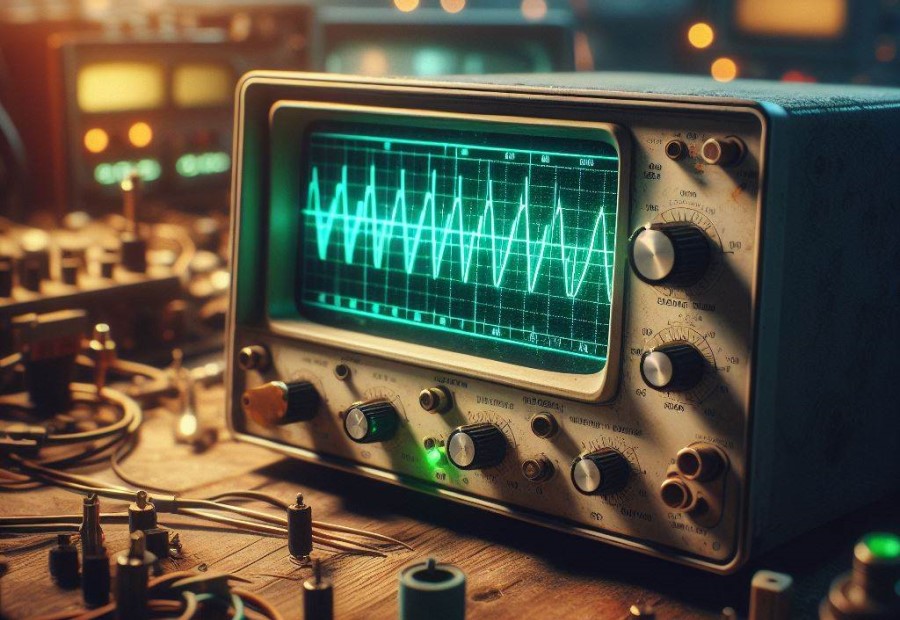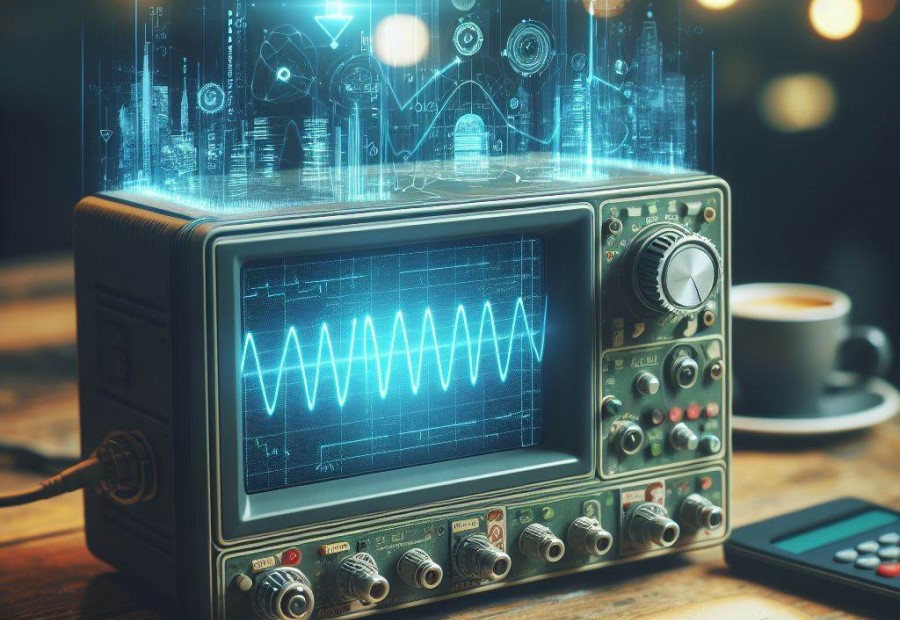Scope measurements play a crucial role in electronics and engineering fields, allowing professionals to analyze and interpret signals accurately. Whether you’re using an oscilloscope or a digital storage oscilloscope (DSO), understanding how to read scope measurements is essential for troubleshooting, analyzing, and validating electronic circuits and signals.
This article will provide a comprehensive guide on reading and interpreting scope measurements, covering voltage, time, frequency, amplitude, and phase measurements.
Firstly, let’s explore the fundamentals of scope measurements. Scope measurements are important tools because they provide valuable insights into electrical waveforms, enabling engineers to assess signal characteristics, identify abnormalities, and measure signal stability. Understanding the scope display is crucial as it serves as the visual representation of the input signals, allowing users to observe and measure voltage over time accurately.
To comprehend scope measurements, it is essential to understand the various types of scope displays. These include analog oscilloscopes, digital storage oscilloscopes (DSOs), and mixed-signal oscilloscopes (MSOs). Each type offers unique features and advantages for different applications and measurement requirements.
Once familiar with the scope display, it becomes easier to read and interpret scope measurements. This involves understanding voltage measurements, time measurements, frequency measurements, amplitude measurements, and phase measurements. These measurements provide valuable information about the input signals, such as their amplitude, frequency, time period, and phase relationship.
Furthermore, scope measurements can assist in troubleshooting and analyzing signals. Engineers can identify signal abnormalities, such as noise, distortion, glitches, or unexpected fluctuations, using scope measurements. Measurements can help measure signal stability and determine if the signal exhibits unwanted variations over time.
For more advanced users, scope measurement features include automated measurements, cursors and measurements, and math functions and measurements. These features provide convenient tools for precise and efficient analysis, allowing users to perform mathematical calculations, analyze specific portions of the waveform, and automate repetitive measurement tasks.
To ensure accurate scope measurements, it is essential to follow tips and best practices. These include understanding the scope’s specifications, correctly setting up the inputs and probes, choosing appropriate measurement parameters, and considering noise reduction techniques. Adhering to these practices will help users obtain reliable and precise scope measurements.
By gaining a thorough understanding of how to read scope measurements and utilizing the various measurement features, engineers and electronics enthusiasts can effectively analyze and interpret signals, troubleshoot issues, and make informed decisions in their projects.
Why are Scope Measurements Important?

Scope measurements are important for several reasons.
- Accuracy: Scope measurements provide precise and reliable information about various parameters. They allow for accurate voltage, time, frequency, amplitude, and phase measurements, which are crucial in many applications.
- Troubleshooting: Scope measurements help identify signal abnormalities, detect noise and distortion, and measure signal stability. These insights are invaluable when troubleshooting electronic systems or analyzing signal quality.
- Advanced Features: Understanding scope measurements enables users to make the most of advanced features like automated measurements, cursors and measurements, and math functions and measurements. These features enhance efficiency and provide deeper insights into the signals being measured.
- Optimal Performance: By utilizing scope measurements, users can ensure that their electronic systems are performing at their best. It allows for precise adjustments, calibration, and optimization to achieve the desired performance levels.
- Diagnostic Tools: Scope measurements act as diagnostic tools, providing valuable information about the performance and integrity of electronic circuits. They help pinpoint issues, identify areas for improvement, and ensure the overall functionality of systems.
Understanding Scope Display
To gain a thorough comprehension of the understanding scope display, it is essential to thoroughly examine and evaluate the different constituents that constitute the display. One effective approach to accomplish this is by constructing a table encompassing pertinent columns. This table presents a lucid synopsis of the data.
The table comprises of headings such as “Time Base,” “Vertical Scale,” “Trigger Level,“ and “Waveform Type.“ The “Time Base“ column denotes the time duration per division exhibited on the display, whereas the “Vertical Scale“ column represents the voltage per division. The “Trigger Level“ column exhibits the voltage at which the waveform is triggered, and the “Waveform Type“ column delineates the nature of the waveform being showcased.
By diligently studying and examining these facets, one can acquire a more comprehensive understanding of the scope display and adeptly interpret the measurements.
What is a Scope Display?
A scope display refers to the visual representation of signals on the screen of a digital storage oscilloscope (DSO). It provides a graphical view of electrical waveforms, allowing users to analyze and interpret these signals. The scope display consists of a grid, divided into horizontal and vertical divisions, which helps in measuring and scaling the signals accurately.
The horizontal divisions represent the timebase, allowing users to measure the time duration of various signal components. The vertical divisions represent the voltage, allowing users to measure the amplitude of the signals.
A scope display also includes various features and controls such as triggering, which helps in synchronizing the display of repetitive signals, and waveform persistence, which allows users to view multiple waveforms overlaid on each other for comparison.
By analyzing the shape, amplitude, and timing of signals on the scope display, users can gain insights into the behavior, characteristics, and potential issues of electronic circuits or systems. This information is crucial for troubleshooting, analyzing, and designing electronic devices or circuits.
Reading and Interpreting Scope Measurements

Reading and interpreting scope measurements is crucial for comprehending and analyzing electronic signals. To effectively accomplish this, you need to follow these key steps:
- Begin by properly setting up your oscilloscope. Ensure that the probe is connected correctly and the settings are appropriate for the signal you are measuring.
- Adjust the timebase settings to capture the desired time period, which will determine the horizontal scale on the display.
- Next, modify the vertical scale to accurately display the amplitude of the signal, enabling you to measure the voltage levels precisely.
- Utilize the cursors to measure specific points on the waveform, such as the peak voltage, time period, or frequency.
- Take note of any irregularities or distortions in the signal as they could indicate issues with the electronic circuit or interference.
- Interpret the measurements by comparing them to the expected values. Consult the specifications of the device or circuit you are testing to determine if the signal falls within the desired range.
- Consider the context of the measurement, taking into account the purpose of the signal and the circuitry being tested. This will assist you in accurately interpreting the results.
By following these steps, you can effectively read and interpret scope measurements, enabling you to troubleshoot electronic circuits, analyze signals, and make informed decisions.
How to Read Voltage Measurements?
When it comes to reading voltage measurements on a scope, there are some simple steps to follow:
- Start by setting the time base to a suitable setting, such as 1ms per division, to get a clear view of the voltage waveform.
- Adjust the vertical scale to ensure that the waveform is properly displayed on the screen. Set it to a range that allows you to see the entire waveform without any distortion.
- Locate the voltage measurement markers on the scope display. These markers typically appear as brackets or cursors on the waveform.
- Move the voltage measurement markers to encompass the desired portion of the waveform that you want to measure.
- Read the voltage measurement value displayed on the scope. This value will be indicated on the screen and will correspond to the voltage level of the selected portion of the waveform.
To ensure accurate voltage measurements, keep the following suggestions in mind:
- Make sure the scope is properly calibrated before taking measurements.
- Use the appropriate probes and settings for your specific measurement requirements.
- Avoid excessive noise or interference that could affect the accuracy of the measurements.
- Take multiple measurements and average the results for improved precision.
- Refer to the scope’s user manual for detailed instructions on how to read and interpret voltage measurements.
How to Read Time Measurements?
When it comes to reading time measurements on a scope, it’s important to follow a few crucial steps:
- Start by locating the time measurement feature on your scope display. It is usually displayed as a numerical value or as a waveform.
- Ensure that the time scale or timebase setting is appropriately adjusted. This setting determines the duration of each division on the horizontal axis of the scope display. The smaller the timebase setting, the shorter the time duration represented by each division.
- Identify the time measurement markers or cursors on the scope display. These markers allow you to measure specific time intervals between different points on the waveform.
- To measure the time between two points on the waveform, position the cursors at the desired locations and read the time duration displayed on the scope. This measurement can help you analyze the frequency or period of a repeating signal.
- For more precise time measurements, you may need to adjust the position and width of the cursors. Refer to the scope’s user manual for specific instructions on manipulating the cursor settings.
By following these steps, you can accurately and effectively read time measurements on a scope. Remember to consult the user manual of your specific scope model for any additional guidance or specific instructions.
Troubleshooting and Analyzing Signals with Scope Measurements

When it comes to troubleshooting and analyzing signals with scope measurements, there are key aspects to consider. In this section, we’ll dive into the art of identifying signal abnormalities, detecting noise and distortion, and measuring signal stability.
Get ready to unravel the mysteries of scope measurements and understand how to interpret and make the most of the data they provide. So, let’s dig in and explore the fascinating world of signal analysis!
Identifying Signal Abnormalities
Identifying signal abnormalities is an essential aspect of using a scope for measurement. By actively analyzing the data, you can pinpoint irregularities and address them accordingly. Some common signal abnormalities include:
- Unintended noise: When there is unwanted interference present in the signal, it can distort the accuracy of the measurements. This noise could be caused by external factors or internal circuitry issues.
- Signal distortion: Sometimes, the signal may be distorted, leading to inaccuracies in the measurements. This could be due to factors like impedance mismatch or improper grounding.
- Signal instability: If the signal fluctuates or shows inconsistencies over time, it indicates instability. This could be a result of poor connections or faulty components in the circuit.
- Abnormal waveforms: If the waveform of the signal deviates from the expected pattern, it suggests an abnormality. This could be due to faulty equipment or incorrect settings.
- Outliers or anomalies: Identifying outliers in the data points can help detect abnormalities in the signal. These outliers may indicate faulty components, measurement errors, or other issues.
By being vigilant and attentive while performing scope measurements, you can easily identify such abnormalities. Once identified, they can be addressed through troubleshooting techniques specific to each issue.
Detecting Noise and Distortion
When it comes to detecting noise and distortion in scope measurements, it’s important to follow these steps:
- Start with a clean signal: Ensure that the signal you are measuring is clean and free from interference. This will help in accurately detecting any noise or distortion.
- Adjust the settings: Set your scope to the appropriate settings for the signal you are measuring. This may include adjusting the voltage range, time scale, or triggering options.
- Identify unusual patterns: Look for any irregularities or unusual patterns in the waveform. These can be indicative of noise or distortion.
- Compare with a reference signal: If possible, compare the measured signal with a known good reference signal. This can help in identifying any deviations or abnormalities.
- Use measurement tools: Use the measurement tools available on the scope to quantify the noise and distortion. This can include measuring the peak-to-peak amplitude, signal-to-noise ratio, or harmonic distortion.
- Refine the measurements: Adjust the scope settings or probe position to refine the measurements and get a clearer picture of the noise and distortion.
- Analyze the source: Investigate the source of the noise and distortion. This can involve checking the connections, cables, or components in the signal path.
- Take corrective actions: Once the noise and distortion are detected, take appropriate actions to eliminate or minimize them. This can include shielding the circuit, improving grounding, or filtering the signal.
By following these steps, you can effectively detect and analyze noise and distortion in scope measurements.
Measuring Signal Stability
To measure signal stability, it is essential to consider several factors. The table provided below highlights the important measurements to be taken into account:
| Measurement | Description |
|---|---|
| Peak-to-Peak Variation | Measures the difference between the highest and lowest points of a signal. A stable signal will show a small peak-to-peak variation. |
| Jitter | Refers to the timing variation of a signal. A stable signal will exhibit minimal jitter. |
| Noise Level | Indicates the amount of unwanted interference in the signal. A stable signal will have low noise levels. |
| Drift | Measures the change in the signal over time. A stable signal will demonstrate minimal drift. |
| Amplitude Variation | Shows the consistency of the amplitude of the signal. A stable signal will have a small amplitude variation. |
These measurements aid in assessing the stability of a signal and ensuring the quality and reliability of the captured data. By analyzing these measurements, it becomes possible to identify any abnormalities or inconsistencies in the signal, thus enabling troubleshooting and making necessary adjustments.
It is important to remember that when measuring signal stability, all relevant measurements and their respective values should be taken into consideration in order to determine the overall stability of the signal.
Fact: The measurement of signal stability holds immense importance in various fields, including telecommunications, electronics, and data analysis, as it plays a critical role in ensuring accurate and reliable transmission and interpretation of information.
Using Advanced Scope Measurement Features
Unlocking the full potential of scope measurements is no longer an enigma. Get ready to dive into the world of advanced scope measurement features that will revolutionize your understanding of data. From automated measurements that simplify your analysis to the power of cursors for precise measurements, we’ve got you covered.
And let’s not forget about the magic of math functions that bring a new dimension to your measurements. Brace yourself for a deep exploration of scope measurement mastery.
Automated Measurements
When it comes to scope measurements, automated measurements play a crucial role. Automated measurements serve as a valuable tool, allowing you to swiftly and accurately gather data without the need for manual calculations or interpretations. This not only saves time but also ensures consistent results.
- Efficiency: Automated measurements streamline the data collection process, enabling faster analysis and troubleshooting.
- Accuracy: By eliminating human error, automated measurements provide highly precise and reliable data.
- Consistency: With automated measurements, you can ensure that measurements are taken consistently across different samples or time points.
- Multiple Measurements: Automated systems can perform multiple measurements simultaneously, further saving time and effort.
- Data Visualization: Many automated measurement systems offer clear and visual representations of the data, facilitating easier interpretation and analysis.
Cursors and Measurements
When it comes to using cursors and measurements on a scope, it’s important to understand their functionality and how they can aid in analyzing signals. Here is a table outlining the key aspects of cursors and measurements:
| Cursors | Measurements |
|---|---|
| Cursors help in accurately measuring voltage, time, frequency, amplitude, and phase on a scope display. | Measurements provide precise quantitative data about the signal being analyzed. |
| By setting cursors at specific points on a waveform, you can determine the voltage level, time duration, frequency, and amplitude of the signal. | Measurements accurately quantify signal parameters such as voltage peak-to-peak, frequency, rise time, fall time, and duty cycle. |
| Cursors allow for precise calculation of time intervals, periods, and phase differences between different parts of the waveform. | Measurements facilitate the analysis of signal stability, noise and distortion levels, and identification of any abnormalities. |
| Utilizing cursors in conjunction with advanced scope measurement features can enhance troubleshooting capabilities and signal analysis. | Measurements can be automated and customized to suit specific analysis requirements, making the process more efficient and accurate. |
By utilizing cursors and measurements effectively, you can gain valuable insights into the signals being analyzed and make more informed decisions in various applications.
Math Functions and Measurements
Math Functions and Measurements are essential aspects of scope measurements. By utilizing various math functions and measurements, you can analyze and interpret signals more accurately and effectively. Here is a breakdown of some key math functions and measurements you should consider:
| Math Functions | Measurements |
|---|---|
| FFT (Fast Fourier Transform) | Frequency analysis of a signal |
| Integral | Calculates the area under the curve of a waveform |
| Differentiation | Measures the rate of change of a waveform |
| Averaging | Calculates the mean value of a signal over time |
| Thresholds | Establishes specific voltage or time levels for triggering events |
| Statistics | Provides statistical information about the waveform |
Pro-tip: When using math functions and measurements, always refer to the scope’s user manual for guidance on how to properly configure and interpret the results. Experiment with different functions and measurements to gain a deeper understanding of your signals and improve your troubleshooting capabilities.
Tips and Best Practices for Accurate Scope Measurements
When it comes to accurate scope measurements, here are some tips and best practices that you should keep in mind:
- Ensure proper calibration of your scope before taking measurements to maintain accuracy.
- Use the correct scale or range setting on your scope for the specific measurement you need.
- Minimize noise and interference by keeping your scope and test setup away from electronic devices.
- Take multiple measurements and average them to reduce randomness and improve precision.
- When using a digital scope, utilize the triggering function to stabilize the waveform for a clearer measurement.
- Pay attention to probe attenuation settings and compensate for their influence on measurements.
Frequently Asked Questions
How do I read scope measurements when buying a rifle scope?
When buying a rifle scope, you need to understand the numbers that indicate the magnification power and objective lens diameter. The first set of numbers before the “x” represents the magnification power, while the number after the “x” represents the objective lens diameter in millimeters.
For example, a scope labeled “4×32” has a fixed magnification setting of four times and an objective lens diameter of 32mm.
What does “variable magnification” mean in a scope?
“Variable magnification” refers to a scope that allows for adjustment between two numbers, such as a “3-9×40” scope. This means you can adjust the magnification from three to nine times, stopping anywhere in between. Variable magnification scopes are more versatile but may be more expensive compared to fixed magnification scopes.
How does an objective lens diameter affect scope performance?
The objective lens diameter, measured in millimeters, determines the amount of light that can enter the scope. A larger diameter allows more light to enter the scope, resulting in a brighter image, especially in low-light situations. So, a scope with a larger objective lens can provide better visibility in low light conditions.
What is the purpose of an ocular bell diameter in a rifle scope?
The ocular bell diameter refers to the size of the eyepiece of a rifle scope. It is an important factor to consider as it affects the eye relief, which is the distance your eye needs to be from the scope’s eyepiece to see the full field of view. Spotting scopes often have shorter eye relief distances compared to rifle scopes.
What are the advantages of a variable magnification scope?
A variable magnification scope offers the advantage of adjustability, allowing you to change the magnification level to suit different shooting needs. This makes it easier to acquire targets at various distances and follow moving targets. Variable magnification scopes are popular for precision rifle shooting competitions and are considered more versatile compared to fixed magnification scopes.
How do I choose the right base for mounting a rifle scope?
When choosing a base to connect the rings to your firearm, you need to take into account factors such as the action size and type, barrel thickness, and bolt lift. These factors determine the type of rings needed for a specific scope. Most scopes in America have one-inch main tubes and require one-inch rings for mounting, while some scopes have thirty-millimeter main tubes that require thirty-millimeter rings.

